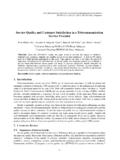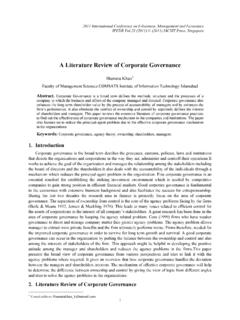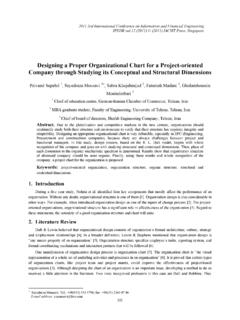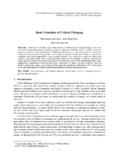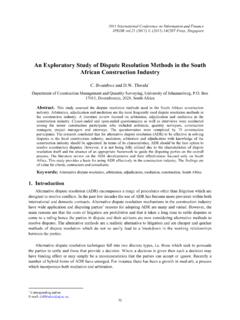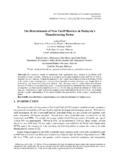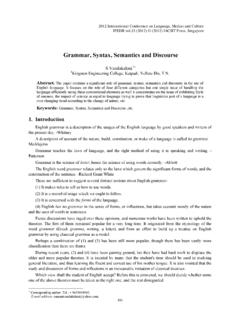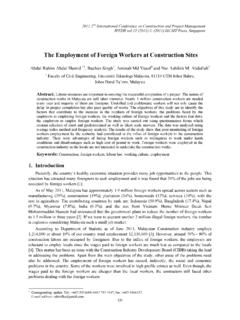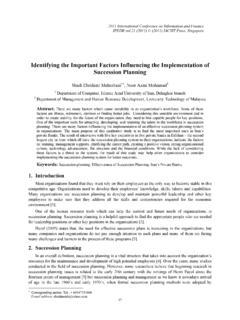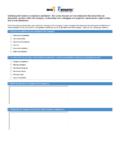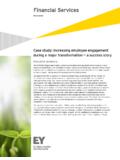Transcription of A critical analysis of Customer Relationship Management ...
1 A critical analysis of Customer Relationship Management from strategic perspective Jayashree Senior Lecturer Faculty of Management Multimedia University Cyberjaya, Malaysia. Somayeh Shojaee Faculty of Management Multimedia University Cyberjaya, Malaysia. Solmaz Pahlavanzadeh Faculty of Management Multimedia University Cyberjaya, Malaysia. Customer Relationship Management (CRM) is the collection of Processes, people and technology that seeks to find costumers of organizations. CRM develops customers retention and Relationship . Progress in Information Technology and organizational changes in Customer -centric procedures have positive effect in the development of CRM. Organizations which implement CRM successfully, will gain Customer loyalty and profitability. One reason of CRM failure is, viewing CRM only as a technology, but to make it successful organizations need to integrate and make balance between process, people and technology.
2 An attempt is made to gauge the impact of environmental elements Viz., Political, Economical, Social and Technological factors on CRM. SWOT analysis is also done and based on the analysis few suggestive strategies and tips are recommended to make CRM practices successful. Keywords-CRM; Customer centric; Customer retention; SWOT I. INTRODUCTION Today, CRM plays the pivotal role for strategic position of an organization. CRM focuses on the integration of Customer information, knowledge for finding and keeping Customer to grow Customer lifetime value. It also has an important role to help organizations to keep their customers and to make them loyal. Organizations should know the reasons of leaving customers and finding the ways of keeping them (Raghu Ramakrishnan, 2005) [14].
3 Therefore CRM role is more important in Customer retention and by regarding the importance of CRM, the analysis of CRM seems to be necessary. II. BACKGROUND CRM comes in 1980. In an early stage of development it was similar to Customer Information System (CIS). The first generation of CIS had single function solution for supporting specific employees. These days CIS has been ripen to CRM, m-CRM, e-CRM. CRM comes in 1990s and has been the most important strategy of customers and businesses for organizations that they invest in CRM. Progress in the 1990 s At this time organizations started to improve in CRM by making bilateral Relationship . Not only organizations gather data for own uses but also they use them to improve Customer services to increase the motivation of Customer loyalty by giving promotions, gifts, bonus etc.
4 On that time CRM increased sales and also improved Customer service. True CRM comes of age Real CRM began early of this century. CRM improved in recognizing the customers needs and behaviors. Advanced solutions were flexible for different industries and they were feasible to use data and information in dynamic way. Flexibility of Internet makes easy Relationship between sales, marketing and Customer service. CRM developed new strategies that accommodated work between understanding, sharing information and goes to increased Customer satisfaction. CRM can get more advantages from high technology corporations, financial services and telecommunication industries. Financial services can track the level of Customer satisfaction, changing habits on buying and make a feedback to the organizations.
5 One of the companies that released Global CRM was Oracle in 2002 (Lucy P. Roberts, 2004-2005) [8]. III. PEST analysis PEST analysis can be categorised into four categories which are: Political, Economic, Social, and Technological forces. A. The Political Factors 1) CRM for e-government concentrates on the requirements of people who use government online services. Public entities are offering their clients a host of a large number of online options, including medical aid, passport 3402010 International Conference on E-business, Management and Economics IPEDR (2011) (2011)IACSIT Press, Hong Kong processing, register complaints, tax filing and disaster help (Dana Norton, 2001) [2]. 2) One of the main functions of CRM is gathering Customer data so it can present security risks when it is used for e-government; hence CRM application providers should pay more attention to the security aspect during implementing the CRM applications.
6 Especially the data of governments are more sensitive. 3) Global competitors across the globe with technological innovations affect the CRM application to more understanding of global Customer s needs for having strong Relationship with them. This type of Relationship is different as Relationship in domestic market so CRM can be affected by different cultures, huge data and so on. 4) Sometimes governments laws stop the businesses from keeping all client information (such as Social Security Number, Home Number, etc.) at an external location so it can affects CRM due to limitations to use the customers personal data. 5) In some situations like involving governments in trading agreements such as OPEC, ASEAN or others the Customer Relationship Management should follow some exceptions.
7 B. The Economic Factors 1) In lower economic performance, organizations or governments need CRM more than others. 2) Today economy is driven by buyers not sellers. There are various types of customers, selling strategies and business models. So CRM should be changed during time to support these models. 3) CRM is more sensitive to rapidly changing market conditions and elasticity in price. 4) The budget of organization also should be considered during making CRM applications; more expensive application can be used only in very large organizations so different types of applications are needed for different budgets. 5) Decreasing in the number of impressive CRM plans results end users asking for more interest in software as a service, more supplier assurances and lower prices.
8 6) These days lots of businesses tend to contract out CRM. At times, cost becomes the driving factor in outsourcing CRM systems. 7) Low or high foreign exchange position can decrease or increase the power of buying; so it has direct effects in market situation especially international market. C. The Social Factors 1) Lifestyles: Different life-styles can be used for developing promotion campaigns, product positioning and market segmentations. Hence it has direct and indirect impacts on CRM (Vince Kellen, 2002) [17]. 2) Buying habits: For having successful CRM, organizations should learn about the habits and requirements of their customers for predicting future buying models and finding new chances to add value to the Relationship (Lucy Fusaro, 1999) [7].
9 3) Customers needs at various times: For having a good CRM database, organizations need to store information at various times like customers' economic status or age. Finding customers various life stages to identify a regular or a seasonal shopper (Ellen Smith, 2009) [3]. 4) Employee s business knowledge: Organizations should motivate their employees to be absolutely Customer centric. CRM problems come from employee s hesitance to be more customers focused so the result is an expensive Customer strategy to retain customers. 5) Customers IT knowledge: The level of customers IT knowledge and education also can affect the design of CRM applications; it should be more user friendly for lower levels. 6) Salespersons knowledge: Salespersons with knowledge of selling, spending more time for customers that results more selling and increase in Customer satisfaction.
10 D. The technological factor CRM applications can use more advantages of technology; CRM application provider can use technology to gathering data, producing knowledge to predicting the behavior of customers and patterns of trade. Central foundation to CRM applications are Data warehouses, enterprise resource planning (ERP) systems and the Internet (Injazz J. Chen, Karen Popovich, 2003) [4]. 1) Data warehouse technology: A data warehouse is storage of data. Data warehousing transforms customers related data into Customer intelligence for finding the customers behavior (Story, 1998) [15]. Some benefits of data warehouse for CRM are: a) Correct and faster access to information makes facilitate responses to Customer requests b) Preventing duplicate data and filtering to remove bad data c) By quickly extract, control and drill-down of data makes Customer visibility, profitability analysis and retention modeling d) Advanced data integration and data analysis tools for making better standard reports e) Calculate present value and estimate future value of every Customer (Injazz J.
